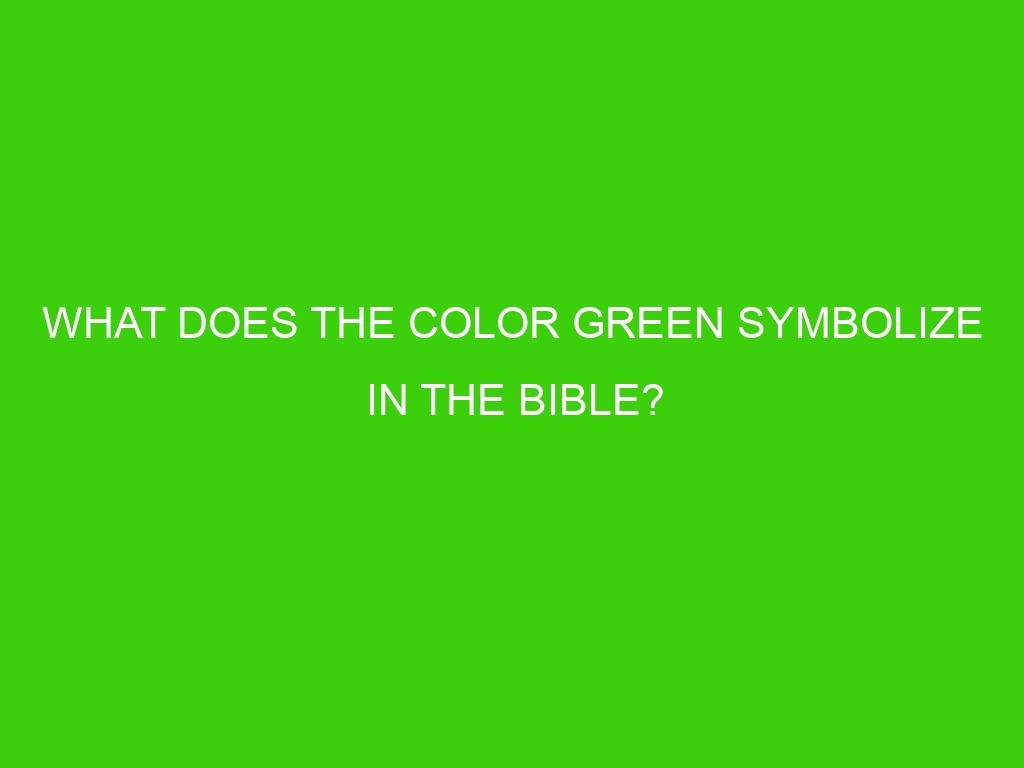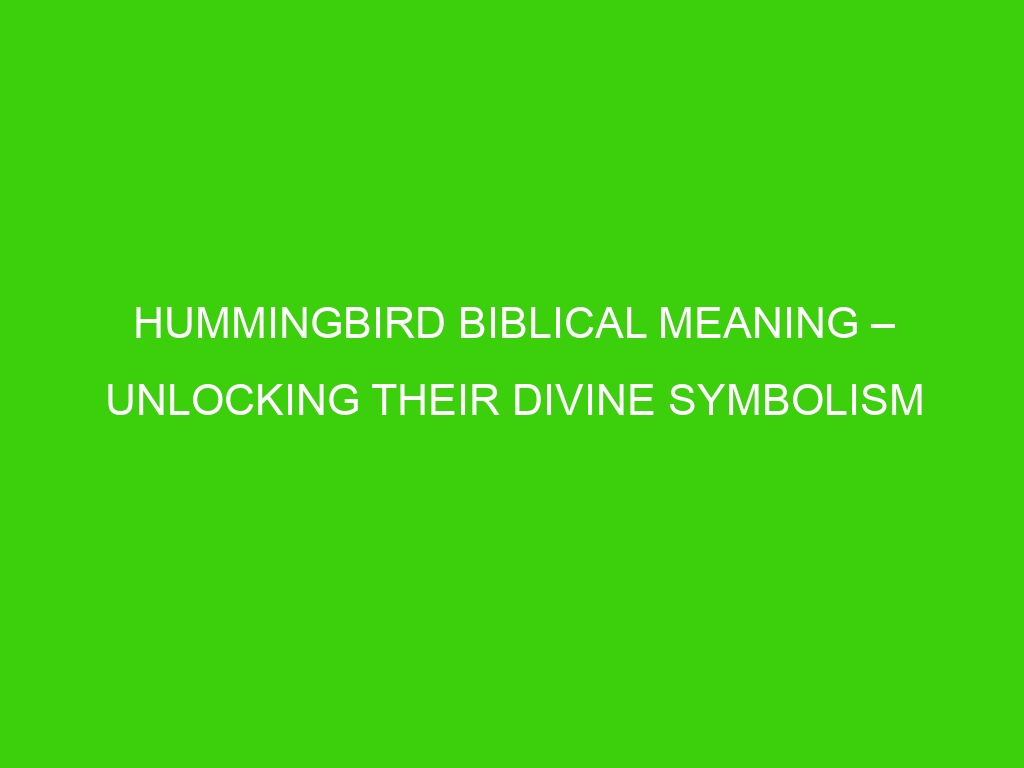You’ve probably never thought much about the color green when reading the Bible.
But did you know that the color green actually symbolizes some important concepts in Scripture? In fact, paying attention to the color green can give you a deeper understanding of key biblical truths.
Stick with me as we take a look at the overlooked color green and what it represents in God’s Word.
Get ready to see familiar passages in a new light as we explore the significance of the color green in the Bible.
This eye-opening guide will change the way you view the Word of God.
So buckle up and get ready to be amazed at how much meaning can be packed into a single color!
The Significance of Colors in the Bible
In the Bible, colors often have symbolic meanings.
Green is no exception.
Growth and Life
Green is commonly associated with growth and life in the Bible.
After the great flood, God gave Noah the rainbow as a sign of his promise, with green representing new life.
Psalms 23 refers to God leading us to “green pastures”.
Green symbolizes fertility, growth, and new life.
Prosperity and Blessing
Green is also a symbol of prosperity and blessing in the Bible.
In Jeremiah 11:16, Israel is referred to as a “green olive tree, fair and of goodly fruit”.
The olive tree and its oil were important sources of wealth in Israel.
Likewise, in Psalm 37:35, the faithful are compared to a “green bay tree” to represent their prosperous state.
Eternal Life
Green is used to represent eternal life in the Bible.
In Revelation 22, the leaves of the tree of life are said to be for “the healing of the nations.” The tree of life bears 12 kinds of fruit and has leaves that are “green and full of sap.” This green, life-giving tree in the new Jerusalem represents eternal life in fellowship with God.
Restoration
Sometimes green is used to symbolize restoration.
In Job 29:19, Job refers to his prosperous past saying, “My root was spread out by the waters, and the dew lay all night upon my branch.” Here the green branch reaching out over the water signifies a time of restoration, growth and stability in Job’s life.
As you can see, green is a meaningful color in scripture.
Whether it’s representing new life, prosperity, eternal life or restoration, green reminds us of the abundant blessings we have in Christ.
Green in Nature – A Symbol of Life and Growth
In the Bible, the color green often represents renewal, growth, and life.
When you think about it, that makes perfect sense.
Green is the color of nature, and nature is the very embodiment of life and vitality.
Plants and Trees
In the Bible, plants and trees are frequently used as symbols for life and growth.
The psalmist compares the righteous man to “a tree planted by streams of water, which yields its fruit in season and whose leaf does not wither” (Psalm 1:3).
Trees represent steadfastness, fruitfulness, and eternal life.
Fields and Pastures
Vast, green fields and pastures also represent abundance and fertility in the Bible.
For example, Psalm 23 depicts green pastures as a place of provision and rest: “He makes me lie down in green pastures, he leads me beside quiet waters” (v.
2).
Green pastures symbolize God’s gracious provision and care for His people.
The Color of Spring
The greening of the landscape in springtime represents new life after winter’s death.
When the earth awakens from its wintry slumber, green shoots emerge from the ground and new buds appear on barren trees.
This renewal of life each spring signifies hope, growth, and prosperity.
The color green pervades the natural world, representing the vibrancy and freshness of life.
So when you see references to green in the Bible, think of growth, renewal, and abundant life.
Green is ultimately a symbol of God’s reviving and sustaining power.
Green Representing New Life and Hope in the Scriptures
Throughout the Bible, the color green is used to represent new life, growth, and hope.
When God created the Earth, He made plants and called them “good” (Genesis 1:12).
Plants, especially green leafy ones, signify life, nourishment, and prosperity.
The color of thriving vegetation
In the ancient Near East, green symbolized thriving vegetation and agricultural fertility.
Many references to green in the Bible represent renewal, freshness, and nourishment.
King David spoke of God making him “lie down in green pastures” (Psalm 23:2).
Jeremiah compared false prophets to a fading “leaf” (Jeremiah 8:13).
And Hosea used “green plants” as a metaphor for Israel’s early devotion to God (Hosea 14:8).
A sign of restoration and healing
Green also signifies restoration and healing.
When the exiles returned to Jerusalem, they were like “green olive trees” (Psalm 52:8).
Ezekiel prophesied that God would restore the land by making “very many trees on the mountains” (Ezekiel 34:25-29).
And in Revelation, John saw “the leaves of the tree [of life] were for the healing of the nations” (Revelation 22:2).
A color of growth and prosperity
In many Bible stories, green symbolizes growth, prosperity, and God’s blessing.
Joseph had a dream of green wheat stalks, representing years of plenty (Genesis 41:1-36).
And Psalm 1 compares the righteous to “trees planted by streams of water that yield their fruit in its season” (v.3).
Green is the color of life, nourishment, and hope in the Bible.
It signifies God’s renewal of creation, His healing and restoration of our lives, and the growth and prosperity He provides.
The next time you see green plants, grass or trees, remember the hope and new life God offers through faith in Jesus.
Jesus as the “Green” Branch – Symbolizing Life and Fruitfulness
In the Bible, the color green is often used to represent life, growth, and fruitfulness.
As the “green” branch, Jesus symbolizes these qualities.
In John 15:1-8, Jesus says, “I am the true vine, and my Father is the gardener.
He cuts off every branch in me that bears no fruit, while every branch that does bear fruit he prunes so that it will be even more fruitful.”
Life through Jesus
As the vine, Jesus is the source of life for the branches (his followers).
Without the vine, the branches can do nothing.
They will wither and die.
By remaining in Jesus, the branches gain life and the ability to bear fruit.
Jesus says, “No branch can bear fruit by itself; it must remain in the vine.
Neither can you bear fruit unless you remain in me.” By believing in Jesus, you gain eternal life.
Growth through the Spirit
The branches that remain in Jesus, the vine, will grow and become fruitful.
This growth and fruitfulness comes through the work of the Holy Spirit in the lives of believers.
The Spirit works in us to produce the fruit of love, joy, peace, patience, kindness, goodness, faithfulness, gentleness, and self-control.
These qualities, manifested in our lives, demonstrate that we are truly disciples of Jesus.
Purpose and mission
As fruitful branches, believers have a God-given purpose and mission.
We are called to bear lasting fruit – fruit that will remain.
This means making disciples and impacting lives in a way that continues beyond our own lives.
We are also called to glorify God through our fruit.
When others see the fruit of the Spirit in our lives and the lives of fellow believers, they see evidence of God’s transformative power and grace.
Our fruitfulness brings glory to the vine, Jesus himself.
By remaining in Jesus, the green branch, we gain life, experience growth through the Spirit, discover our purpose, and fulfill our mission to bear lasting fruit that glorifies God.
What a beautiful picture of the Christian life! Our fruit depends entirely on our connection to the true vine.
Remain in him, and you will bear much fruit.
Green Biblical Meaning FAQs: Common Questions About Green Symbolism in the Bible
What does the color green symbolize in the Bible?
Green is the color of life, growth, and fertility in the Bible.
It represents renewal, revival, and restoration.
Green symbolizes a fresh start as plants come alive again in the spring.
It is often associated with growth in faith and spiritual renewal.
Why is green an important color in the Bible?
Green signifies new life and new beginnings.
In the Old Testament, green branches were used in religious ceremonies.
The Israelites used green branches in the Feast of Tabernacles to rejoice over the fall harvest.
The prophet Isaiah used the green pine tree and myrtle as symbols of God’s faithfulness.
What verses mention the color green in the Bible?
Several verses point to the importance of green in the Bible:
- Psalm 1:3 compares a righteous man to “a tree planted by streams of water, which yields its fruit in season and whose leaf does not wither.” Green, fruitful trees represent spiritual prosperity.
- In Jeremiah 17:8, God says “They will be like a tree planted by the water that sends out its roots by the stream.It does not fear when heat comes; its leaves are always green.” Green leaves symbolize steadfast faith that does not fade in times of hardship.
- In Luke 23:31, Jesus says “For if they do these things when the wood is green, what will happen when it is dry?” Green wood represents living, faithful people.Dry wood symbolizes those who lack spiritual life.
- Revelation 9:4 refers to the “green grass” that locators were told not to harm.Green grass signifies ordinary people going about their lives.
- Mark 6:39 describes how the people sat “on the green grass” to eat the loaves and fishes that Jesus multiplied.Sitting on the green grass highlights how God provides abundantly for our basic needs.
What else does the color green represent in the Bible?
Green also symbolizes prosperity, harmony, fertility, and eternal life in the Bible.
It is the color of lush gardens, verdant pastures, and the Garden of Eden.
Green points to God’s provision and the Paradise He has prepared for His faithful servants.



